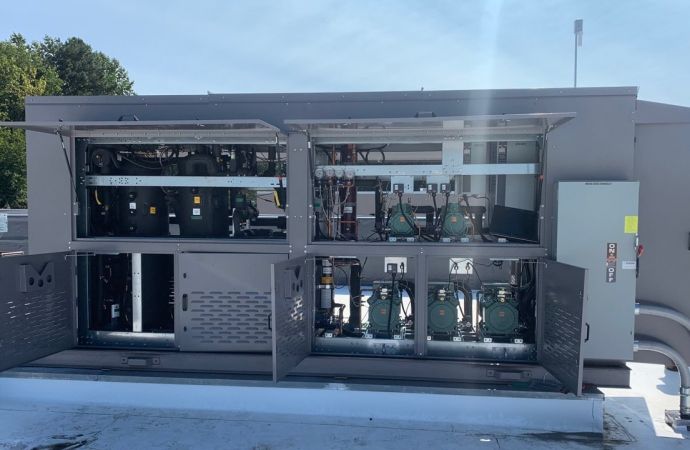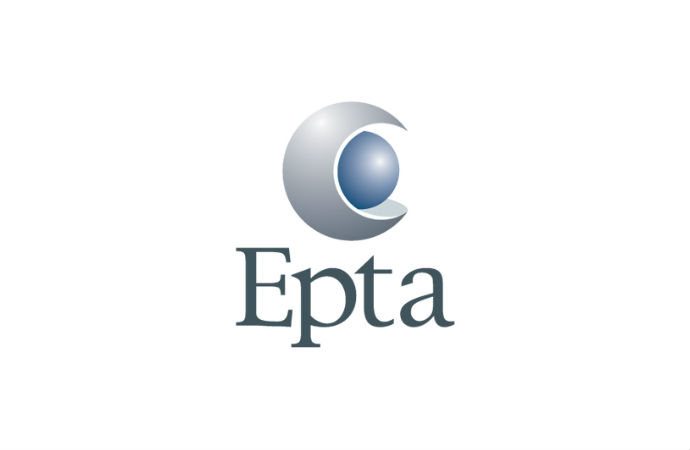Five stores in the southern U.S. will use FTE technology to increase efficiency in warm climates.

Transcritical CO2 rack with FTE technology installed in the U.S.
Nineteen months after acquiring U.S. refrigeration manufacturer Kysor Warren, Italian OEM Epta has started installing transcritical CO2 (R744) systems incorporating FTE (Full Transcritical Efficiency) technology in the U.S.
To date, Kysor Warren Epta US, Epta’s U.S. division, has installed two transcritical FTE systems – the first deployed seven months after the acquisition – and three more are being commissioned this year, said Daniele Mazzola, technical marketing manager of Epta, during an online presentation October 20 at the ATMOsphere America conference. (shecco, publisher of this website, is the organizer of ATMOsphere America.)
All five systems are in new stores. Four of the five stores are located in Alabama, Georgia and South Carolina, which have a hot/humid climate, with ambient temperatures up to 40°C/104°F. The other is located in Tennessee, a moderate climate. None of the systems use water.
The two initial systems “are running fine, overcoming the most demanding summer conditions,” Mazzola said. “There have been some learnings and fine-tuning as expected with the test sites as we push the technology to its limits to ensure we are providing the market with the best CO2 solution.”
Epta’s plan is to make the FTE technology “well-known in the U.S. market and accepted by installers and service companies alike,” said Mazzola.
During his ATMOsphere America presentation, Mazzola explained in detail how the FTE system works. Introduced in Europe in 2017, the FTE system employs a low-pressure liquid receiver to flood medium-temperature evaporators with liquid CO2. This eliminates superheat and allows the evaporation temperature in the cabinets – and ultimately the efficiency of the system – to increase.
The FTE systems in the U.S. have increased evaporation temperature by 4°C (7°F), he said.
Globally, more than 1,600 of Epta’s transcritical CO2 systems – almost 400 using FTE technology – have been installed, 90% in Europe. About 90% of the installations have been at stores, with the rest at warehouses and food process facilities.
Efficiency gain of 10%
Mazzola noted that, because the FTE technologyworks on the evaporative side of the system, it provides efficiency in any climate conditions. Compared with a traditional transcritical CO2 booster system, FTE delivers more than 10% energy savings, with installation and maintenance costs that are 20% lower, he said.
The lower maintenance costs stem from the fact that FTE uses standard components (solenoids valve, check valve, liquid sensors, electromechanical control board) that are widely available and can be easily removed from the main system. “Any technician is able to manage and service an FTE system,” explained Mazzola. “Although additional training can be provided to the maintenance teams, the effort to became an FTE expert is low.”
With lower operating costs, a transcritical system with FTE offers a payback on the premium paid over a conventional transcritical system, varying from six months to two years, said Mazzola. “The payback depends on the energy costs, the size of the store and the temperature profile of the location.”
By contrast to the FTE system, other energy-enhancing technologies used in transcritical equipment, such as adiabatic gas coolers, parallel compression and ejectors, can enhance performance only in warm and hot environments, said Mazzola. Some installed FTE systems – as well as standard non-FTE Epta transcritical systems – use these additional technologies, though their use “is optional and at the discretion of the customer.”
“Adiabatic or other technologies are not required when using FTE to experience benefits in terms of efficiency and system reliability in warm environments,” Mazzola said. “Epta also believes that FTE is more cost effective than other options in the market and has “more advantages compared to liquid ejectors.”
This year, Epta introduced FTE 2.0, an updated version of FTE. With FTE 2.0, Epta has integrated the low-pressure receiver into the power rack to take up less space and reduce installation and start-up time.
Also new in 2020 is the ETE (Extreme Temperature Efficiency) system, recommended for very warm climates, even over 40°C (104°F). The ETE includes a heat exchanger that subcools a portion of the CO2 coming out of the gas cooler. An electronic expansion valve (EEV) then delivers expanded refrigerant at an intermediate pressure to the high-pressure line.
Epta believes that ETE has more advantages than parallel compression, and that adiabatic gas coolers will gradually be replaced by ETE and FTE technology.
FTE 2.0 and ETE were developed as part of the Life-C4R project, funded by the EU. The project is designed to accelerate the dissemination and implementation of highly efficient CO2 refrigeration systems.
Adiabatic or other technologies are not required when using FTE to experience benefits in terms of efficiency and system reliability in warm environments."
– Daniele Mazzola, Epta
Related stories



